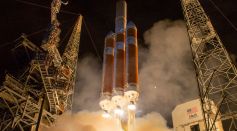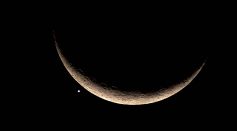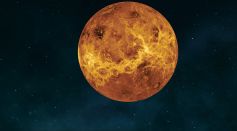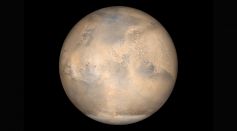Tags: Venus

NASA’s Parker Solar Probe Nears Venus for Historic Close Pass to the Sun

November Skywatchers: Crescent Moon Meets Bright Venus for a Stunning View
Venus, Earth and Jupiter May Have Something To Do With the Sun’s Multi-Rhythmic Solar Heartbeat [Study]
Japan Loses Contact With $300 Million Venus Spacecraft Akatsuki After Operation in Late April

Venus Volcanoes: Brightest Planet in the Solar System Is More Volcanically Active Than Thought, Could See Earth-Like Eruptions [STUDY]
Venus Lost Water and Dried Out Due to Chemical Reaction HCO+ Dissociative Recombination [Study]
Mercury-Bound BepiColombo Spacecraft Observes Cold Oxygen and Carbon Ions Escaping the Induced Magnetosphere of Venus
Mysterious ‘Glory’ Spotted for the First Time Outside Our Solar System in the Alien World WASP-76b
Venus-Mars Conjunction Happening Soon: Here's How To Catch the Two Planets Side by Side
Venus’ Mini Satellite Is the First Identified Quasi-moon in the Solar System; Zoozve Earned Its Name by Human Error
Mars and Venus Are Due to Merge Later This Month; How to Watch the Appulse?

Illuminated Venus Remains Bright at Morning Sky; Catch It Before It Disappears in Dawn Light
Is Venus Spinning the Wrong Way? Why Does Earth’s Twin Rotate Backwards?

Ice Clouds in Venus' Inferno: Unveiling the Surprising Chilled Layers Above the Scorching Surface
Venus Is Inhabitable; Life Could Exist Within Planet’s Thick Clouds of Sulfuric Acid [Study]
Images of Venus From Venera Mission Look Forbidding
Venus' Occultation Behind Crescent Moon Captivates Sky-Watchers Across Europe and Russia

NASA's Retired Telescope Detects Atomic Oxygen on Venus's Day Side, Shedding Light on Atmosphere Differences

Celestial Highlights This Week: Watch Out For the Venus-Moon Conjunction, Meteor Shower, and More
Venus May Have Had Earth-Like Plate Tectonics That Support Life Long Time Ago [Study]
Most Popular

Largest Known Volcanic Aquifer Discovered Beneath Oregon's Cascades

New 'Supergiant' Sea Bug Found in South China Sea, Named After Darth Vader

Mediterranean Sea Was Refilled by a Catastrophic Flood Millions of Years Ago

Mysterious Cosmic Waves That Sound Like Birds Detected in Unexpected Space Region





